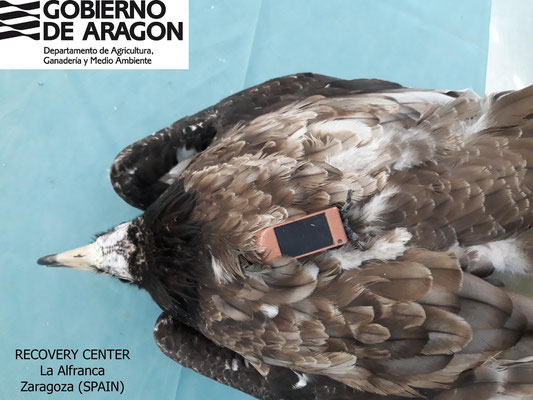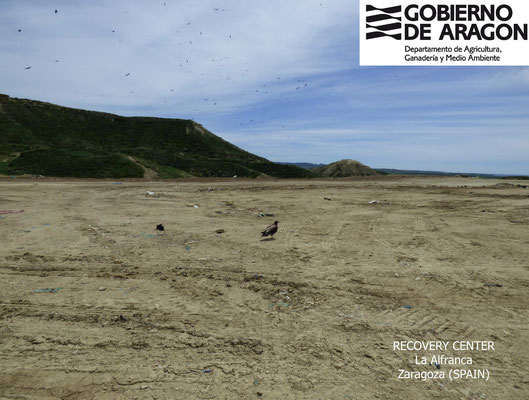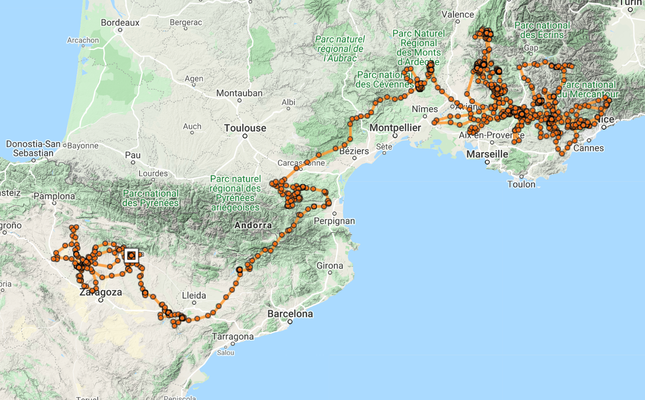
The Egyptian Vulture Buoux did not have a smooth start in life. The vulture that hatched in 2018, already needed to be rescued and released twice. Now, it returned back to the wild, and we are closely monitoring its movements to ensure it’s well.
First rescue and release
The young Egyptian Vulture Buoux hatched in Baronnies in 2018 and was ringed in the nest by Vautours en Baronnies. One week after leaving its nest, the vulture was found injured. Its parents already left for their autumn migration, and the young bird spent the first days flying around by itself. It was found in September by a team from LPO PACA and brought to the rescue centre ‘Centre régional de sauvegarde de la faune sauvage‘ in Buoux. The young bird had injuries on one wing, but what caused the injuries is not confirmed, perhaps by an eagle attack. The The Centre in Buoux took good care of the young Egyptian Vulture during winter and brought it to Villeperdrix at the end of March to get the bird ready for release. It spent a few days in an aviary, surrounded by the local vultures. All four species of Vultures can be found at this site, also thanks to the LIFE GypConnect project, which reintroduces the Bearded Vulture to the region. Before the release, the young bird was also equipped with a GPS tag. The tag was provided by the Vulture Conservation Foundation (VCF) and was funded by the MAVA Foundation. Tracking and studying the movements of vultures using GPS technology is important to inform targeted conservation actions. And in the case of Buoux, this saved its life.
Second rescue and release
Just two months after tagging the vulture’s first rescue and release (and a long journey from France to Spain), we realised that something was wrong with Buoux thanks to the GPS data. The last known location of Buoux was around Huesca in Aragon, so we informed our colleagues from the ministry in Aragon about the situation who immediately went to the field and rescued the bird in time. They transferred Buoux to Egines Recovery Centre on 27 June 2019 where they determined that Buoux broke its wing due to a collision with a cable. After almost a year in rehabilitation, the vulture made a full recovery and was ready for release!
Ahead its release, the Government of Aragon, tagged the vulture with a GPS transmitter once again. On 6 May 2020, Buoux was released back to the wild. The vulture is now mainly around a nearby garbage dump. The technicians of Aragon check on Buoux in the filed a few days after the release, and it seems it seems that the vulture is not alone. It moves around and flies with other Egyptian Vultures and Griffon Vultures in that area. The VCF will continue to monitor the movements of Buoux. We hope that Buoux will not need any assistance from us again and that it will have a long life in the wild. You can track the movements of Buoux by visiting our online public maps.
Mitigating the threat of collisions
Collision with power lines occurs when vultures are unable to distinguish the powerline against the background of the natural vegetation as they use them to navigate or fly near them. According to the Vulture Multi-species Action Plan (Vulture MsAP), co-developed by us here at the VCF, and endorsed by the Convention for Migratory Species, energy infrastructure particularly electrocution and collisions pose an often-overlooked threat to vulture species across the world. The deaths from these threats are sadly underreported, for example, in Spain, only 10% of the mortality caused by collision is recorded.
The Vulture Conservation Foundation (VCF) is involved in different project to mitigate the threat of collision. There are many projects, including our own LIFE-funded projects such as LIFE Rupis, Vultures Back to LIFE, LIFE GYPHELP and LIFE Re-Vultures, that are working to protect vultures from the risks posed by the electricity infrastructure by adding high visibility reflectors and spirals to cables to help improve the visibility of power lines which reduces the risk of collision with power cables. The MAVA Foundation is also funding projects across the eastern Mediterranean flyway to minimise the danger of electrocution and collision.
Egyptian Vultures in France
In the nineteenth century, the Egyptian Vulture was present in all the Pyrenees, the Mediterranean area and up the Rhone Valley to Switzerland. Today there are around 80-100 breeding pairs of the species in France. There are two distinct populations in the country, the largest is found in the western Pyrenees consisting of around 80 pairs attached to the larger Spanish population of the Pyrenean regions of Navarre and Aragon. The second population is in the Mediterranean region extending from the regions of Herault to the Alpes de Haute Provence and consists of around 20 breeding pairs.









